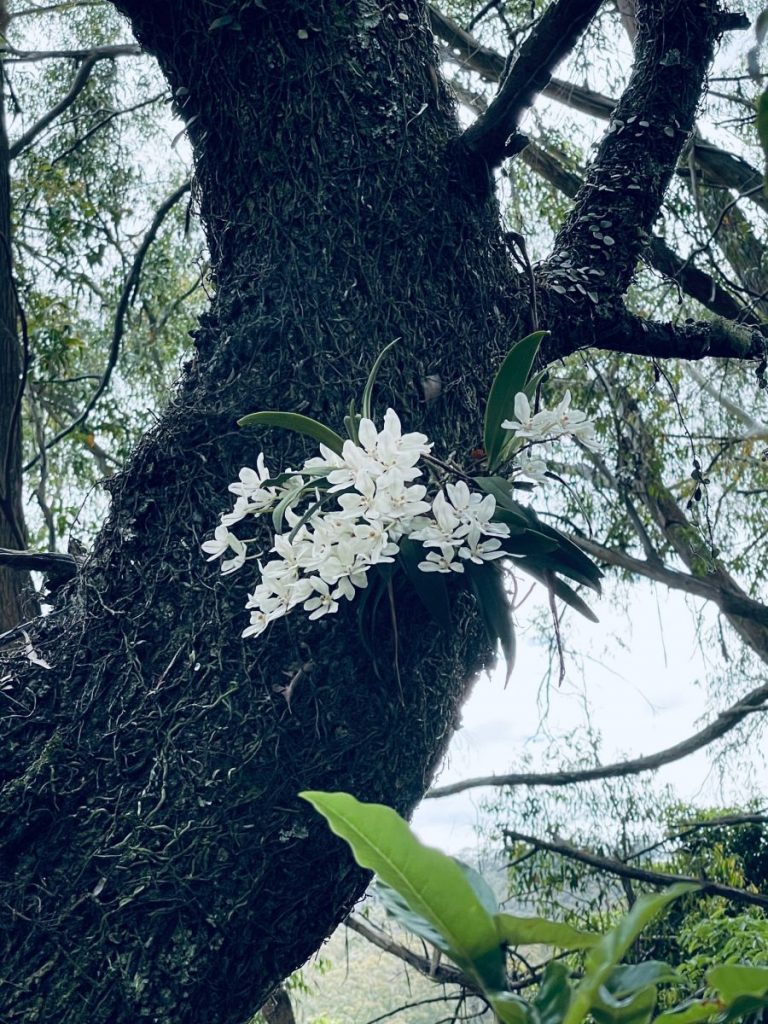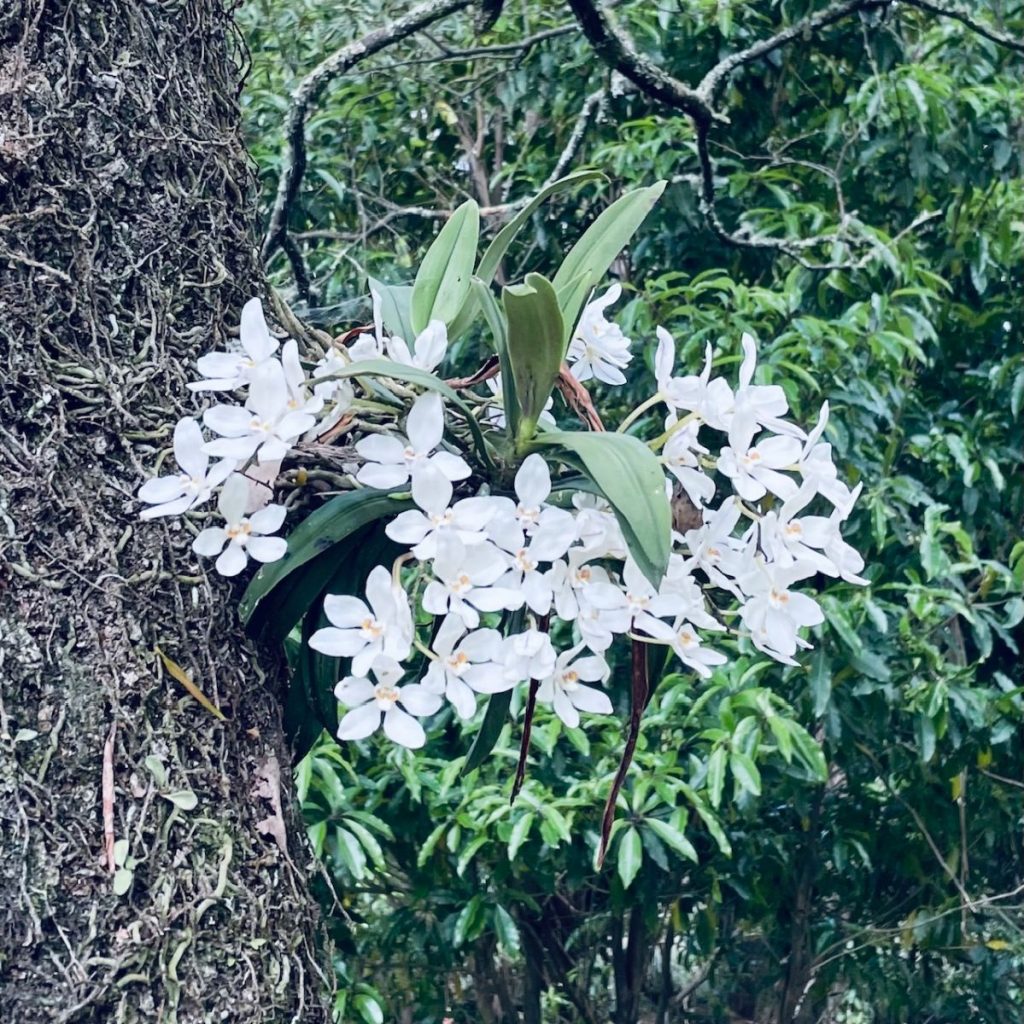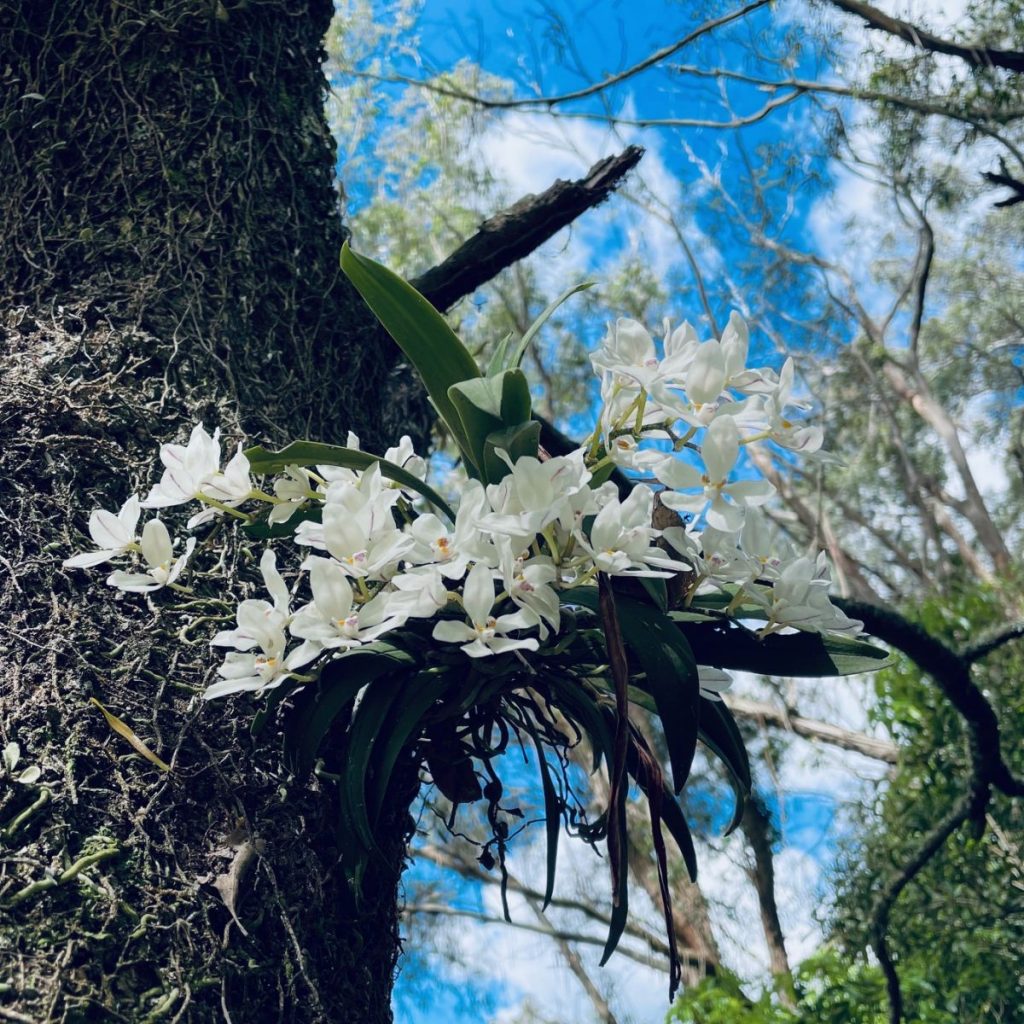Glenda Browne summarises recent queries focused on orchids, and answers from our experts group.
For more information, newsletters of the ANPSA Orchid Study Group (now in recess) are preserved at http://anpsa.org.au/orchids.html
Propagating Sarcochilus falcatus – Orange Blossom Orchid
Q: This Sarcochilus falcatus – orange blossom orchid – was discovered during a weeding session on Mount Murray. It is located up a blackwood and was in full flower in early October. I would appreciate any assistance other members can offer on how to collect seed and best propagate.
A: The replies emphasised the need for a licence for wild collection of orchid seeds, the small size of the seeds, and the difficulty propagating them.
Wild collection of ANY orchids must be conducted under a NPWS licence (regardless of where they are growing). Obtaining a licence is difficult, and usually requires some sort of overall project rather than a randomly found specimen that you want. It would probably be easier to remember where you found it and make sure it gets protected so it can be appreciated in years to come. Weeding remote areas is a great way of finding and appreciating many hidden and subtle gems of our bush.
The growing of orchids from seed is a specialised task and many of the methods are very technical – think lab type settings. A slightly less involved method is described at http://anpsa.org.au/APOL20/dec00-14.html#orchid. There is also a specialist orchid group – the Australasian Native Orchid Society – which has many members who are adept at growing orchids from seed. Here is a link if you want to try ‘flasking’ orchid seeds – http://www.bromeliadorchid.com.au/GROWERS%20GUIDE/ORCHIDS/Fundamentals%20Of%20Flasking/Fundamentals%20Of%20Flasking.htm. There are also a number of specialised Sarcochilus orchid breeders around who also grow from seed, eg, https://barritaorchids.com/collections/sarcochilus and https://www.duno.net.au.
The APS Blue Mountains group was hoping they would be viewing this orchid at Mount Wilson at the end of October.



Purchasing native orchids
Q: I was wondering if you guys propagate and sell any native orchids.
A: Epiphytic orchids are sold by some nurseries and groups as they are easily propagated by division. Glenbrook Native Plant nursery had some Sarcochilus species for sale at $20 each, but they are only available when the nursery can purchase them. Ground orchids are sold by some specialised nurseries such as Nesbits in South Australia.
Orchids and the (non)inventor of Monopoly
Susan Orlean’s book The Orchid Thief includes a note that Charles Darrow invented Monopoly and retired to raise orchids. We received an email from a reader of our website, who said that this is not just incorrect, but perpetuates a gross intellectual theft. She wrote ‘Just like dozens… hundreds… of other inventions in recorded history, a woman invented the game and a man stole the idea, patented it and became famous and very rich from her idea and work.’ She wrote to us because this ‘fact’ was included in one of the articles on our website.
We have now corrected the website comment. The true story can be found at https://www.europeana.eu/en/blog/the-story-of-monopoly-how-charles-stole-lizzies-idea-and-made-his-fortune
Orchid naming – Dendrobium and Thelychiton
This section developed from an email discussion by members of APS Newcastle group after reading an article by Jeff Howes noting new names of some orchids.
Q: A member had just read an article that stated that the genus Dendrobium has been changed to the genus Thelychiton and that D. kingianum and D. speciosum are no longer part of the genus. She had never heard of this before and was wondering why it was claimed as a new genus.
A: In summary, the genus Dendrobium has been used for a wide range of plants, including many that are more closely related to orchids in other genera. True Dendrobium is the group of soft-cane Dendrobium from India. There is no way Australian Dendrobiums, whether the terete-leaf species, Cooktown orchids or the Sydney rock lilies, are closely related to soft-canes, and they should not be in the same genus.
There is some politics in the research into Australian orchids and the decisions that are made about their naming. It also seems to take some time for proposals to get wide acceptance and general use.
The name change from Dendrobium to several new genus names, one of which is Thelychiton, was made in 2006 by David Jones in A Complete Guide to Native Orchids of Australia. Although the Australian National Botanic Gardens recognises the Jones changes, no State herbarium does, including the Royal Botanic Gardens NSW. The RGB indicates that they are likely to recognize the names when/if “detailed phylogenetic analysis supporting their monophyly is published. Until then they have chosen to treat them as synonyms of a broadly circumscribed Dendrobium”. Since the required analysis has still not been published, Dendrobium remains the correct name in NSW.
When the changes are implemented, the genus name Dendrobium will not die out entirely in Australia. There is one Australian Dendrobium left! It is Dendrobium stuartii, the fringed tree orchid, which is found in NE Queensland, as well as in Indonesia and New Guinea.
History and more information
Peter Vaughan provided some history and more information on the changes, writing:
This comes down to politics, insufficient research, and personal opinion.
Reasons not to accept the splits
Two German botanists divided Dendrobium and Bulbophyllum into many genera. What they did needed to be done, however these botanists had never touched the Australian or New Guinea species, and did it all by looking at plant descriptions and pictures in books. Their research was insufficient and what they did was wrong, both ethically and scientifically. This is a major reason why their work is ignored. However, no matter how wrong it is, it is not completely wrong, and the right bits still have precedence, and if we accept the splitting of these genera then we have to accept many of their names.
The many hundreds of new genera that are proposed would be too unwieldy. Many genera will only have one species. Each of Dendrobium and Bulbophyllum have up to 2,000 species, or more, and may be divided into hundreds of genera. Many Australian species would be the only species in their genus, and by looking at the name we have no idea of its relationship to other species. By keeping them in Dendrobium and Bulbophyllum, we immediately know their relationships.
Once we split the genera, the rules of nomenclature state that we have to keep close relatives together, but no one has done the research to determine the closest relatives within Dendrobium and Bulbophyllum. So even if we support the splitting, it cannot be done accurately at this stage as we do not know the phylogeny, ie the closest relatives.
Leading on from the last point, where do we make the splits? What appear to be distinct genera often have intermediate species between other genera. This is also a big problem with Eucalyptus, and the intermediate species are often primitive species, from which the new genera/subgenera have evolved. We don’t know where to place these ancient species. More research is needed here.
Splitting species
Some splits seem too pedantic. Natural variation is natural, obviously. When does variation become great enough to warrant plants to be given new species status, or only a variety, or subspecies? Birds vary. A species of bird will be larger in colder climates, and darker in more heavily forested environments. We know this. Insects can be expected to have similar variation due to local environmental conditions. As insects pollinate orchids, the orchids have to adapt and the flowers will be slightly different. There is a fantastic set of photographic books covering the pollinators of Victorian terrestrial orchids. The photographers, who are scientists, discovered in different areas, a species of orchid may have different pollinators. This should not make the orchids different species. It is natural variation. We should accept some variation.
Reasons to accept the splits
It is obvious that the variation within Dendrobium is too great to maintain. For example the terete leaf species, that is Dockrillia, have little in common with D. speciosum and its relatives, and they need to be separated. Easily done. But what about D. lichenastrum and D. toressae, Should they be Dockrillia? Do we make a new genus for just two or three species. The purpose of the genus is to group similar species together so we can see their relationships. We soon find many genera only have 1–3 species, but that reflects their true evolutionary isolation. Perhaps that is important. I can also recall Dendrobium Pink Pencil is a hybrid between D. teretifolium and D. kingianum. Scientific reasoning tells us that if species can hybridise, they are from the same genus. That’s a problem.
We should recognise variation for conservation purposes. Even if they are varieties of the same species, varieties are important genetic units. To make it clear to decision makers, it is often better to recognise individual species, to assist the argument for conservation.
Conclusion
Well I don’t know what is correct, though I would like to see some splitting. In the end they are all beautiful plants, and when we discuss them we recognise what we are talking about, that is what is important.
Thanks to John Aitken, Mark Abell, Ralph Cartwright, Sue Crabbe, Rhonda Daniels, Gordon Deans , Carolyn Diamond, Alix Goodwin, Mark Henley, Jeff Howes, Heather Miles, John Nevin, Anthony and Annabelle O’Halloran, Merle Thompson, Dick Turner, Peter Vaughan and our external correspondents.
Read more
Read more answers from our experts group to queries about native plants here, here and here.
